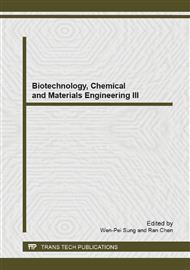p.485
p.490
p.494
p.498
p.503
p.507
p.512
p.516
p.522
Properties of Anaerobic Activated Sludge in Biohydrogen Production Reactor
Abstract:
For the properties of activated sludge studies, three kinds of activated sludge were obtained from continuous hydrogen production reactor. Activated sludge was got under organic loading rate (OLR) of 3, 7 and 25 kgCOD/m3·d condition, respectively. Sedimentation performance and activities of sludge were investigated. When OLR was 3 kgCOD/m3·d, activated sludge showed good sedimentation performance. After 30 minutes sedimentation, the volume of activated sludge in total mixture volume was about 39%. When OLR was 7 and 25kgCOD/m3·d, after 30 minutes sedimentation, the volume of activated sludge in total mixture volume was 80% and 83%, respectively. The increase of biomass is the main reason for increase of sedimentation performance. MLVSS/MLSS of activated sludge was 37.7% and 79.6% under OLR of 3 and 25kgCOD/m3·d condition, therefore, activities of activated sludge was high under high OLR condition. Since sedimentation performance of sludge is high under high OLR condition, hydraulic retention time should controlled carefully in engineering operation.
Info:
Periodical:
Pages:
503-506
Citation:
Online since:
January 2014
Authors:
Price:
Сopyright:
© 2014 Trans Tech Publications Ltd. All Rights Reserved
Share:
Citation:


